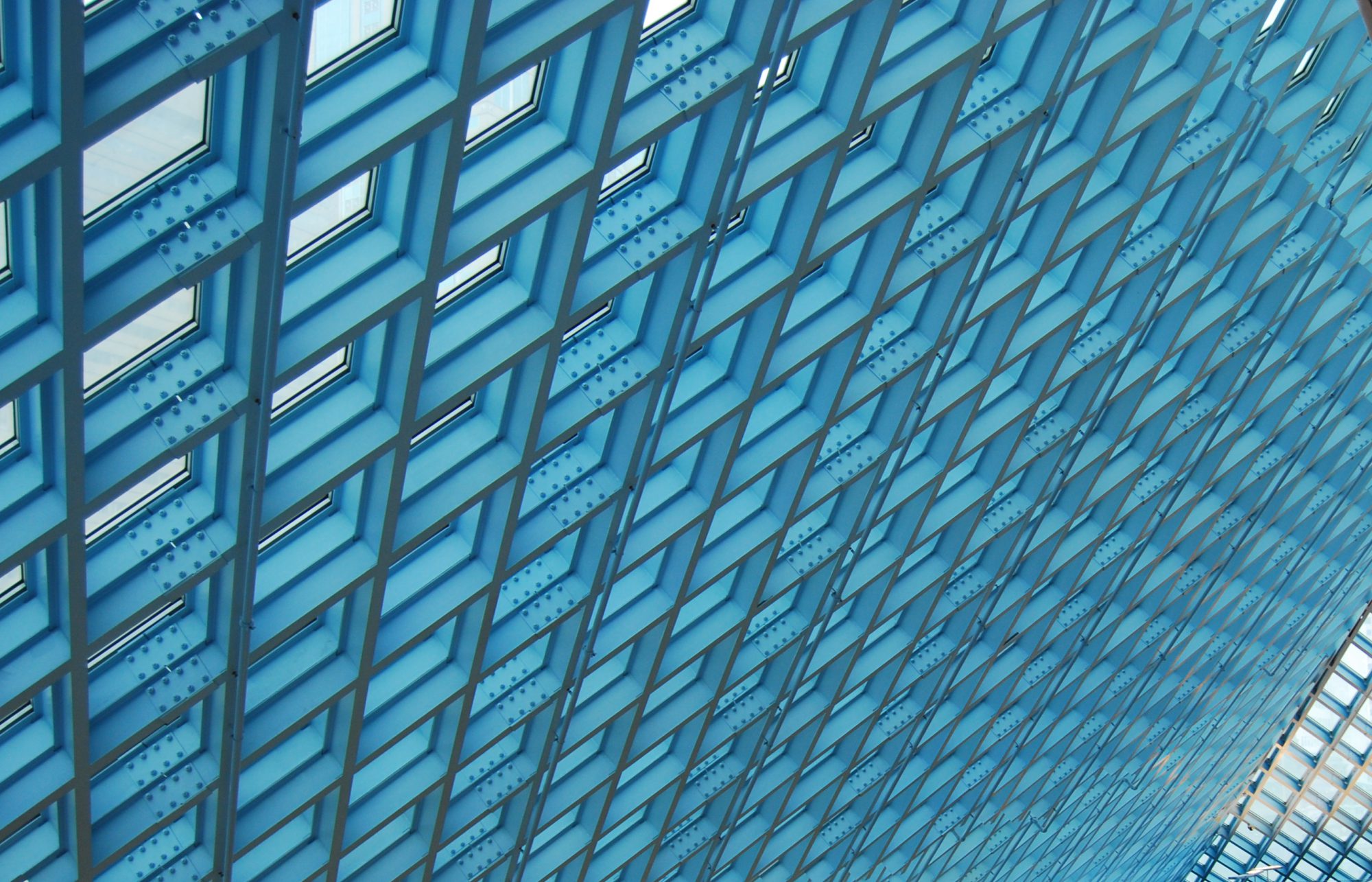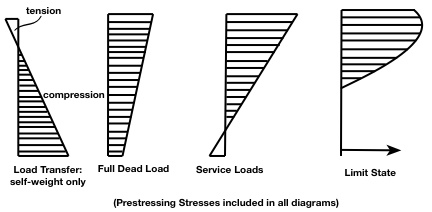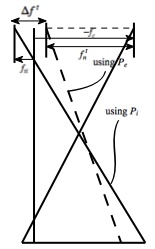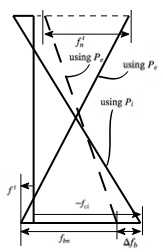We will need to use the following allowable limits:
![]() is the maximum allowable compressive stress in the concrete immediately after transfer and prior to losses
is the maximum allowable compressive stress in the concrete immediately after transfer and prior to losses
(1) ![]()
![]() is maximum allowable tensile stress in the concrete immediately after transfer and prior to losses
is maximum allowable tensile stress in the concrete immediately after transfer and prior to losses
(2) ![]()
for simply supported members at the supports,
(3) ![]()
![]() is maximum allowable compressive stress in the concrete after losses at service-load level
is maximum allowable compressive stress in the concrete after losses at service-load level
(4) ![]()
![]() is maximum allowable tensile stress in the concrete after losses at service-load level
is maximum allowable tensile stress in the concrete after losses at service-load level
(5) ![]()
What has been left out in the simplified equations so far are the intermediate analysis checks that are required. It has been mentioned on a couple of occasions so far, that there are two values for ![]() (
(![]() and
and ![]() ). There are a lot more values in between, but these two will govern. It makes intuitive sense that if the beam is fully loaded, then the beam will deflect more, hence larger compressive and tensile (if present) stresses will result, if, the tendon force is
). There are a lot more values in between, but these two will govern. It makes intuitive sense that if the beam is fully loaded, then the beam will deflect more, hence larger compressive and tensile (if present) stresses will result, if, the tendon force is ![]() rather than
rather than ![]()
![]() . So, it is conservative to use the smaller for a fully loaded
. So, it is conservative to use the smaller for a fully loaded ![]() condition (i.e. self-weight + superimposed dead load + live load).
condition (i.e. self-weight + superimposed dead load + live load).
However, what about at an intermediate loading stage, such as a time when there is more compression on the bottom fiber than the top fiber? A realistic scenario could be that the beam is prestressed, and no load except the self-weight is applied. Shrinkage and other factors have not yet occurred in the beam, so the tendon is still stressed to ![]() (not
(not ![]() ) .
) .
The more conservative value of ![]() to use in this condition (
to use in this condition (![]() only) is to use
only) is to use ![]() .
.
Let’s investigate this further:
By setting the expressions equal to ![]() , as shown, we have enough information, just using geometry, to determine that must be satisfied.
, as shown, we have enough information, just using geometry, to determine that must be satisfied.
These expressions for ![]() and
and ![]() will be independent of
will be independent of ![]() and
and ![]() !
!
(6) ![]()
We can take the “![]() ” out of our second term, and rewrite the second term as
” out of our second term, and rewrite the second term as
(7) ![]()
So,
(8) ![]()
Similarly, skipping the work,
(9) ![]()
So, regardless of the values of ![]() and
and ![]() , the DIFFERENCE in stresses after prestressing losses ONLY depends on material, geometry, and applied moment.
, the DIFFERENCE in stresses after prestressing losses ONLY depends on material, geometry, and applied moment.
(![]() is negative, so (
is negative, so (![]() ) is positive)
) is positive)
The “![]() ” in
” in ![]() stands for “net”, and
stands for “net”, and ![]() designates “top”.
designates “top”.
So, with ![]() ,
, ![]() positive, and
positive, and ![]() negative:
negative:
(10) ![]()
(11) ![]()
(![]() and
and ![]() are positive and
are positive and ![]() is negative)
is negative)
(12) ![]()
(13) ![]()
Again, we see that the DIFFERENCE in stresses between stages is independent of ![]() and
and ![]()
From inspection of the very first diagram, using what we know about the definitions of ![]() and
and ![]() from the latter two diagrams, we can see that:
from the latter two diagrams, we can see that:
(14) ![]()
(15) ![]()
(16) ![]()
(17) ![]()
These expressions assume that the stresses at both the transfer and service stages are largest at a single point along the beam – i.e. at midspan for a simply supported beam with draped tendons.
If ![]() and
and ![]() , then whatever
, then whatever ![]() and
and ![]() that cause
that cause ![]() and
and ![]() in the intermediate stage, will cause
in the intermediate stage, will cause ![]() and
and ![]() at the full service load stage, when
at the full service load stage, when ![]() and
and ![]() are added, and
are added, and ![]() becomes
becomes ![]() . Any
. Any ![]() and
and ![]() and
and ![]() are obviously conservative (i.e.
are obviously conservative (i.e. ![]() and
and ![]() that cause
that cause ![]() and
and ![]() in the intermediate stage, would have stresses less than
in the intermediate stage, would have stresses less than ![]() and
and ![]() at the full service load stage).
at the full service load stage).
For a continuous beam, one would need to evaluate the above two expressions for the midspan and for the support (i.e. two sets of expressions) and use the largest set of values, keeping in mind that “![]() ” is in fact
” is in fact ![]() for a typical interior support and
for a typical interior support and ![]() would be
would be ![]() for the interior support. This is due to the fact that the applied loads would produce negative moment, and so the tendon would be draped so as to be located within the upper half of the section, at the interior supports.
for the interior support. This is due to the fact that the applied loads would produce negative moment, and so the tendon would be draped so as to be located within the upper half of the section, at the interior supports.
The above two expressions would really only apply to a continuous beam in the circumstance where a single “set” of expressions controls (either at midspan or at the support). If, say, the midspan controls at transfer and the support controls at service loads, then the above expressions may either be too conservative or too aggressive. Regardless, the above equations are a good starting point, though rules-of-thumb are equally effective in some cases.
Note: the self-weight of the structure (![]() ) depends on
) depends on ![]() , thus, the above equations aren’t perfect even for a simply supported beam with draped tensions, which is essentially the assumed geometry under which the above equations were derived.
, thus, the above equations aren’t perfect even for a simply supported beam with draped tensions, which is essentially the assumed geometry under which the above equations were derived.
For a simply supported span with straight tendons, most likely, the support stresses at the transfer stage would control at the transfer stage, and the midspan stresses would control at the service load stage. This is analogous to the scenario mentioned previously, regarding a continuous beam where the midspan controls at transfer and the support controls at service loads. For a continuous beam, developing new expressions for ![]() and
and ![]() would be cumbersome. For a simply supported beam with straight tendons, we can simply eliminate the
would be cumbersome. For a simply supported beam with straight tendons, we can simply eliminate the ![]() term from
term from ![]() and
and ![]() since the stresses at the support at the transfer stage ONLY result from prestressing. The self-weight moment (and applied moments from gravity) is zero at the pinned supports. Stresses at midspan resulting from
since the stresses at the support at the transfer stage ONLY result from prestressing. The self-weight moment (and applied moments from gravity) is zero at the pinned supports. Stresses at midspan resulting from ![]() are still assumed to govern at the service load stage, but
are still assumed to govern at the service load stage, but ![]() and
and ![]() now include an
now include an ![]() term, since the
term, since the ![]() terms no longer cancel.
terms no longer cancel.
Thus, we arrive at the following two expressions for a simply supported beam with straight tendons (often used in parking garages):
(18) ![]()
(19) ![]()
These expressions assume that the stresses at transfer control at a point along the beam where there is no external moment and the stresses at service control at a different point along the beam, where there is moment – i.e. a simply supported beam with straight tendons.




